What criteria should meet the new sink in the bathroom
During the overhaul of a separate bathroom or combined bathroom, it makes sense to replace outdated sanitary appliances, among which the sink takes the most place. In addition to the daily morning toilet procedure, it is also often used for other purposes, such as hand washing, hand washing and rinsing small items, washing and cleaning household items, as well as carrying out daily water and hygiene procedures.
Taking into account the above, modern bathroom sinks must comply with ergonomic and hygienic requirements, and also have decent aesthetic qualities.
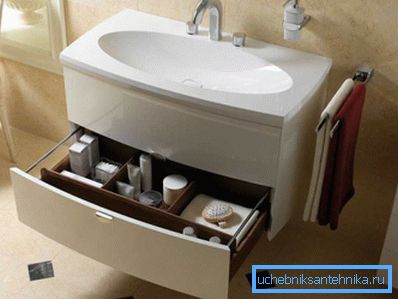
How to choose the most suitable sink for the bathroom
At present, a wide variety of all kinds of sanitary appliances for the bathroom is offered on the market for repair materials, the price of which largely depends on the manufacturer, the material of manufacture, the degree of originality of the design, and the ease of use and availability of various additional functions.
To make it easier for the reader to choose the most appropriate option, this article will provide an overview guide, which describes the main positive and negative qualities of the main types of household sinks found on the market.

Main selection criteria
Going to the store building materials, you need to have a rough idea of the nature of the future purchase, which should be based on personal preferences, practical recommendations and feedback from other people.
However, it should be remembered that in order to choose the most suitable version of the sink, you must also take into account many other various factors.
- The shape and dimensions of the sink in the bathroom must be selected in accordance with the architectural features and the geometric dimensions of the room as a whole, and in particular the places for its installation.
- In addition, when choosing a form and a color, it is also necessary to take into account the color scheme and the accepted concept of decorative design of a bathroom so that the sink after installation does not stand out from the general uniform style.
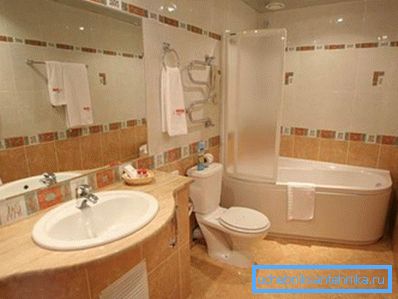
- By way of fixing, both large and small sinks in the bathroom can be wall-mounted, floor-mounted, overhead, or overhead, so in order to make the right choice, you need to figure out the possibility of fixing the sink to the wall, as well as decide on the presence and placement of other pieces of furniture and sanitary appliances in the bathroom.
- Another important condition is the compliance of the installation, drain and technological holes, summed up by engineering communications. In this case, you need to pay attention to such moments as the size and location of the hole for the sink faucet in the bathroom, as well as the diameter and location of the sewer pipe.
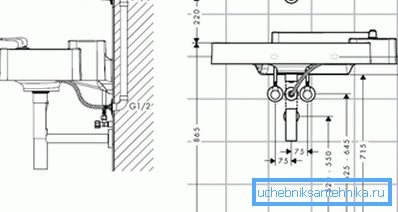
Tip! One of the really useful additional functions is the presence of a built-in water overflow system, which will help protect the apartment from the flood in the event of the overlapping of the drain hole with a rubber stopper, or other objects that have accidentally entered it.
Body material and manufacturing features
The main requirements for the shell shell material are sufficient mechanical strength, ecological and hygienic cleanliness, resistance to water and dirt, ease of daily care with household detergents, as well as high or satisfactory aesthetic qualities.
Based on these considerations, the following materials are most widely used for the manufacture of household sanitary appliances:
- Sanitary faience is the most common and inexpensive material, and is a white or colored bathroom sinks made of special baked ceramics, which are covered with durable and smooth waterproof glaze. They have good hygienic properties, they wash easily enough, they withstand well the effects of all types of household chemicals, but they are easily destroyed under the influence of a shock load or sudden changes in temperature.

- Glass suspended or overhead sinks in the bathroom are made of ordinary silicate glass with a thickness of 12 to 22 mm, and then subjected to quenching at high temperature. Thanks to this treatment, high resistance to impact loads, scratches and external damage is achieved, as well as absolute safety in the event of the destruction of the glass product. In addition, the glass sinks have a light and transparent appearance and are very easy to clean, but they are much more expensive than products made from sanitary faience.
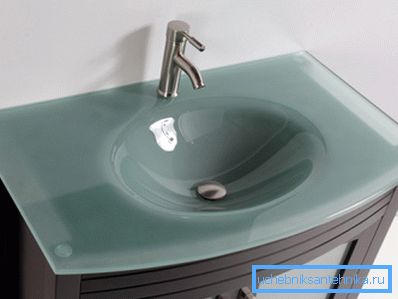
- Stone shells are most often cut from an array of natural marble or granite, and then subjected to wet grinding and polishing. The main advantages of such products are that they are made from environmentally friendly natural material, have very high strength, besides they have an expensive and noble appearance. The main disadvantage is the high cost of the sink for the bathroom, as well as a fairly large weight.
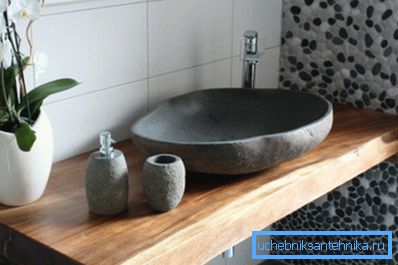
- Sanitary devices from composite semi-natural materials, which are also called artificial stone, are made by combining stone chips or other mineral components with organic binders based on polymer resins.. This technology allows you to adjust the serial production of products that have the properties of natural stone, but their cost will be significantly cheaper.
In most cases, faience products can be mounted directly to the wall, while installing heavier, stone or glass sanitary fixtures requires massive bathroom furniture with two sinks, so if they are used, the bathroom should have a sufficient area.

Note! Often used in the kitchen, enameled or stainless steel sinks, in the bathrooms are installed very rarely, due to the small range of products, and a high level of noise from the falling water flow.
Design performance
Depending on the characteristics of the bathroom, and the specific installation conditions, all household plumbing appliances are available in various designs, so when buying and installing the sink with your own hands, you also need to pay attention to the following points:
- Suspended or suspended models are designed to be mounted directly on the wall through their own mounting holes, or with the help of console mounting brackets.
- Built-in or overhead plumbing fixtures, as a rule, are installed on a special narrow cabinet or commode for a bathroom without a sink, inside which you can hide all engineering communications.
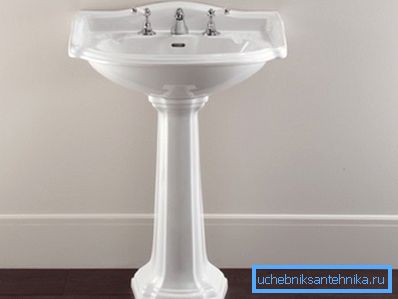
- Pedestals or tulips have a central supporting leg of sanitary faience. This design significantly reduces the load on the wall, and also allows you to hide inside the supporting leg siphon and sewer pipe.
- One or two sinks in the bathroom, made in the form of a bowl of tempered glass or natural stone, as well as overhead, can be installed on a separate countertop or a special cabinet.
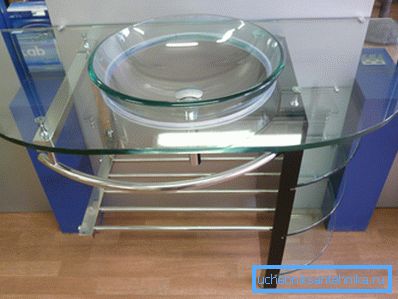
Conclusion
At the end of the article we can conclude that the most important criteria for choosing a bathroom sink are, first of all, a stylish and attractive appearance, as well as the convenience of everyday use, and the availability of original design solutions or additional useful functions will help to finally dispel all doubts and make right choice.
To get more complete information about household sanitary appliances for the bathroom, you can view the video in this article, as well as explore similar materials in this section of our site.